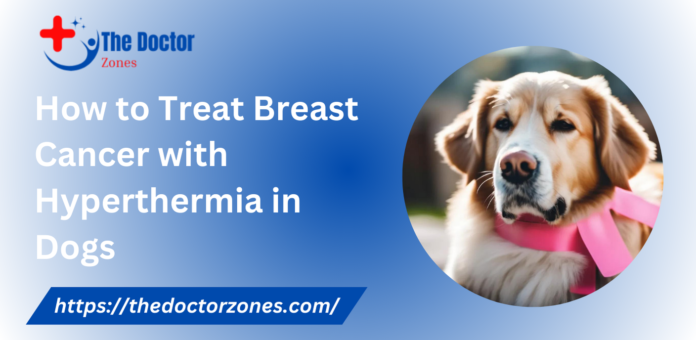How to Treat Breast Cancer with Hyperthermia in Dogs
Hyperthermia therapy for canine breast cancer uses controlled heat to target and destroy cancer cells in the mammary glands. The non-invasive treatment heats tumor tissue up to 41-45°C (105.8-113°F), making cancer cells more vulnerable to damage. and minimizes damage to surrounding healthy tissue. It should be used in conjunction with chemotherapy or radiation to increase treatment efficiency. and helps reduce the size of tumors…possible This procedure is generally safe. It can improve a dog’s quality of life and provide an option for those who are not amenable to surgery. Consult a veterinary oncologist to determine the best treatment plan for your dog.
Also Check Does Arizona Have Breast Cancer? A Complete Guide
Understanding breast cancer in dogs
What is breast cancer in dogs?

Breast cancer, also known as mammary carcinoma, is a tumor that develops in the mammary glands of dogs. It is most common in female dogs that have not been bred, are older or have hormonal imbalances. Breast tumors can be benign or malignant, and the course varies from case to case.
Symptoms and diagnosis
The most common symptoms of breast cancer in dogs are the presence of a lump or large mass in the breast area, swelling, pain, changes in appetite and fatigue A veterinarian usually uses a physical examination, imaging and a combination of physical examinations are used to characterize and stage tumor. Read about Breast Cancer Vaccine: A Promising Future in Cancer Prevention
What is hyperthermia in veterinary medicine?
Hyperthermia is a treatment that uses heat to target cancer cells and tumors. This treatment raises the temperature of tumor tissue, typically up to 41-45°C (105.8-113°F), which can damage cancer cells, reducing damage to surrounding healthy tissue and it can only be used as adjunctive therapy to other such treatments as chemotherapy or radiation therapy.
Discover more Do Parasites Cause Breast Cancer? Step By Step
How does overheating work?
The mechanism of hyperthermia is that it inflames the tumor tissue to further destroy the cancer cells. High temperatures are possible:
- Cancer cells undergo apoptosis (programmed cell death).
- Make other cancer treatments, such as chemotherapy or radiation, more effective.
- Improve the body’s ability to fight cancer cells.
- It prevents blood flow to the cancer site causing the tumor to shrink.
Benefits of hyperthermia in the treatment of breast cancer in dogs
Hyperthermia has several advantages when used to treat breast cancer in dogs:
- Non-invasive treatment: Unlike surgery, hyperthermia is non-invasive, making it a great option for less-than-ideal dogs who may undergo surgery due to age or health reasons
- Targeted therapy: targets the tumor with minimal damage to surrounding healthy tissue.
- In combination with other therapies: Hyperthermia can work synergistically with other therapies such as chemotherapy and radiation therapy, improving efficacy and potentially reducing side effects
- Pain relief: In addition to treating the tumor, heat therapy can help manage the pain caused by cancer.
- No protection against cancerous features: Hyperthermia can be used in various stages of breast tumors, either to reduce the size of the tumor or to prevent it from happening again.
Must Read about Can You Get Disability for Breast Cancer?
Method of treating hyperthermia in dogs
Part 1: Research and planning
Before beginning hyperthermia treatment, the veterinarian will carefully assess your dog’s health, tumor type and cancer stage. This may include imaging tests such as x-rays or ultrasound to understand the tumor size and location. A customized treatment plan will be developed to ensure the effectiveness of heat therapy.
Step 2: Transmission of high frequency light
Hyperthermia therapy itself uses external mechanisms to heat tumor tissue to a specific temperature. This can be done in various ways, e.g.
- Microwave heating: Microwaves are used to heat the bladder.
- Radiofrequency ablation: Electromagnetic waves are used to heat deep tissue.
- Infrared or ultrasound heat: Focuses on the heat applied to the area.
Step 3: Monitor the treatment
During the session, the veterinarian carefully controls the temperature to prevent overheating and damage to the surrounding tissue. Depending on the treatment plan, multiple treatments can be performed over several weeks.
How overheating helps other treatments
Chemotherapy is included
Hyperthermia can significantly improve the effectiveness of chemotherapy by making cancer cells more sensitive to chemotherapy. This combination treatment has shown improved outcomes in reducing tumor size and preventing cancer metastasis.
Synergy of radiation and hyperthermia
Excessive heat in combination with radiation therapy can make cancer cells more susceptible to radiation, leading to fewer drugs and side effects. The heat increases the amount of oxygen in the tumor, making radiation more effective at destroying cancer cells.
Mutations of the immune system
One effect of excessive heat is its alteration of the immune system. It can stimulate the immune system by making cancer cells better recognized by immune cells. This activation of the immune system can help the body fight cancer more effectively.
Safety and adverse effects of hyperthermia in canine mammary carcinoma
Is extreme heat safe for dogs?
Hyperthermia is generally safe for dogs when performed by a trained veterinarian. The process requires careful temperature control to ensure that only cancer cells are targeted, minimizing damage to healthy tissue.
Possible negative consequences
Possible side effects include:
- Local dermatitis: Redness or swelling may appear in the treated area but usually subsides within a few days.
- Short-term discomfort: Dogs may experience minor discomfort during or after the procedure, which can be managed with pain relief.
- Burns or blisters: Rarely, burns or blisters can occur if the temperature is not controlled properly.
Things to consider before choosing hyperthermia for dogs
Breast cancer phase
Hyperthermia may be more effective in some stages of breast cancer. It is often used when the tumor is localized or when surgery is not an option. Your veterinarian will recommend the best treatment based on the type and stage of your dog’s cancer.
Tumor location and size
Tumor size and location are important factors in determining the appropriateness of hyperthermia. Larger tumors may require more frequent procedures, and tumors located deeper in the tissue may require different heating techniques.
Overall health of the puppy
The dog’s overall health and tolerance to treatment are important. Overheating may not be appropriate for dogs with heart disease.
Success rate and prognosis of breast cancer in dogs treated with hyperthermia
Hyperthermia therapy has shown promise to enhance screening in dogs with most breast cancers. While not a guaranteed cure, it can significantly reduce tumor length, improve multidisciplinary outcomes, and improve the dog’s quality of life The cost of success depends on a variety of factors such as the cancer status, the dog strength, and combined on measurements used.
Helping your dog during hyperthermia treatments
Here are some suggestions for helping your puppy with hyperthermia treatment:
- Keep your dog comfortable: Provide a safe place for your puppy to rest after each class, as they will feel tired or experience moderate pain.
- Monitor any side effects: Check for any unusual skin reactions, inflammation, or behavior, and consult your veterinarian if you notice any concerns.
- Stick to a follow-up process: It is important to assess the effectiveness of routine follow-up and make any necessary adjustments.
- Nutrition and Hydration: Be positive that your puppy is well fed and hydrated to help recover and stay averagely healthy.
Future perspectives in hyperthermia therapy in dogs
The field of veterinary medicine continues to gain, dog, tuberculosis and accident treatment are more popular options in technology, and the technology has been engineered. The horizon is coming, the release of personalized medicine plans, the release of burn management products, and a combination of new burn therapies.
Conclusion
Experienced treatment is the hopeful approach with a hopeful approach to the client, as inconceivable, focused on the possibility of alternative therapies such as medication, etc. in addition to medications and radiation be hard in for If anyone considers the excessive regret, please move the cat who is the cat vegetarian to discuss the best ways to meet the needs of your caregivers.








